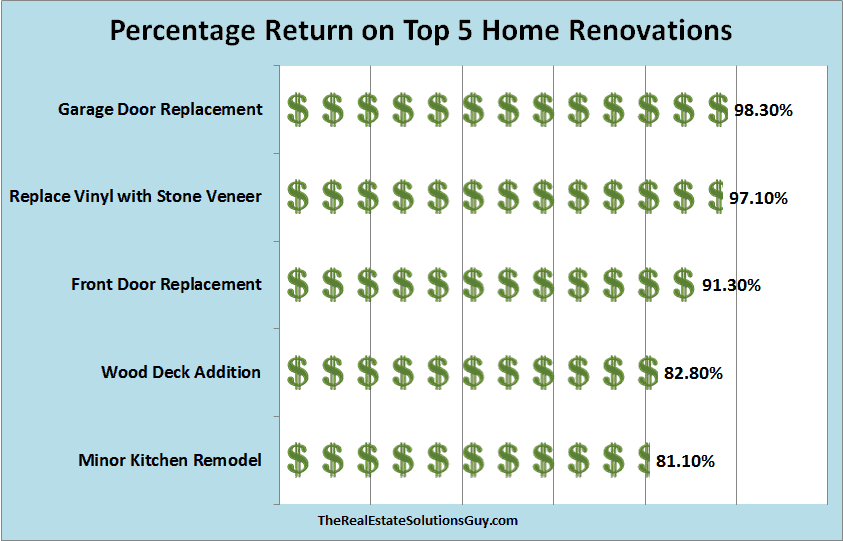Get an as-is cash offer for your home
"*" indicates required fields
Are you thinking of updating your home to sell it for a higher dollar amount? Remodeling your home to sell can be both mentally and financially rewarding if done properly. It can also be a nightmare on your mental health. Here are 5 common mistakes sellers make when remodeling their home to sell.
1. Expecting a dollar for dollar return on remodeling repairs
According to FSBO.com, the biggest mistake sellers make when remodeling their home to sell “is expecting to get a dollar-for-dollar return on their upgrades” The owner may think, “My house is worth $15,000 more than the house down the street. I spent $15,000 on my kitchen.” While home improvements can add value to your home, it is rare that there is a dollar for dollar match.
2. Spending dollars on the wrong remodel projects
Kitchens are often assumed to be the greatest dollar for dollar increase, but their return on investment is only 80%. Some homeowners spend several thousands of dollars on kitchen upgrades, only to not get the return they were hoping for. According to Remodeling Magazine’s Cost versus Value report, there are cheaper renovations that may give you a higher return.
Top 5 Most Cost Effective Home Renovations |
|||
| Rank | Improvement Project | Percentage Return | Average Cost |
| 1. | Garage door replacement | 98.3% | $3,470 |
| 2. | Replace Vinyl Siding with Stone veneer | 97.1% | $8,221 |
| 3. | Front entry door replacement | 91.3% | $1,471 |
| 4. | Wood deck addition | 82.8% | $10,950 |
| 5. | Minor kitchen remodel | 81.1% | $21, 198 |
3. Not having a specific scope of work before you start
If you are shopping for contractors, you must have a scope of work to compare bids. Just as important, the scope of work must be identical for each bid. If you have a different scope of work for each contractor, you will never be able to accurately determine your budget. One of your biggest enemies of staying on budget is what we call scope creep. Scope creep is when your job scope changes as you go along. There are two sources of scope creep.
- Contractors – Often your contractors will have great suggestions for you as they walk through your house. However, don’t let contractors change the scope of work from your original scope. Their suggestions may be helpful, but these changes won’t let you compare bids accurately. Instead, if your contractor suggests changes to your scope of work, ask them to bid that item separately.
- The homeowner -As your project moves along, you will see things that need changing. You need to understand that you are the biggest obstacle to limiting your scope creep. As one real estate agent put it, “Once you start renovating, it’s easy to catch the home remodeling fever. You want to update everything.”
It’s easy to justify the changes. It starts by our saying, “While we’re at it…” Every time we say that, we just added dollars to our project. There will be things you decide to change that were not in your original plan. However, these should all be determined and decided upon before you select or hire your contractor. Did your project scope change after you had a bid from a contractor? That’s fine. Just make sure you submit a revised scope of work to all your preferred contractors before choosing your contractor.
4. Being financially unprepared for contingencies
Many homeowners are financially unprepared for contingencies. Contractors will tell you that remodeling projects rarely go as planned. When you plan a project, homeowners should have a contingency budget in place before starting their repairs. According to Compton Construction, a construction project management company, “Most construction projects use a rate of 5%-10% from the total budget to determine contingency.”
A contingency budget is not in case you change the scope of your project. For example, you decide to replace your kitchen cabinets instead of painting them. This isn’t a contingency. It’s a scope change.
A contingency budget is for the repairs that you don’t know about until you are in the middle of the project. It might be as simple as discovering you need to change the water shutoff valves under a sink when you replace a counter top. Or finding dry rot or termites when you redo your bathroom shower. These unforeseen repairs can range from a few dollars to several thousand dollars.
Not having a contingency budget can mean the difference between finishing your project or not finishing it. Maybe that’s why some 43% of homeowners have unfinished projects that they have started but not completed.
5. Disregarding curb appeal
What was not in the list of Top 5 Most Effective Renovations was your front yard. However, any real estate agent will tell you curb appeal matters. The old saying “first impressions matter” really does. Simple landscaping ideas can change make your home much more attractive. It’s the first thing your prospective buyer sees when coming to your home
Does it make them excited to see the inside? Or do they it’s just another house with real estate sign gimmicks to try and get buyers to come in. Is the lawn green and are the edges trimmed neatly? Are your trees and bushes trimmed? Do the planter beds have nice fresh mulch? If it’s seasonally appropriate, do you have flowers that are blooming? You can hire a landscaper to do this for you, but a homeowner can usually do all that is necessary in a weekend for a few hundred dollars.
Conclusion
In conclusion, focus your money and energy on repairs that will give you the most bang for your buck. Remember, you probably won’t get a dollar for dollar return on your repairs, so be mindful of your budget. Before starting your project, have a written scope of work and be careful of scope creep.
Lastly, don’t forget your curb appeals. With Internet marketing, most buyers will see pictures of the front of your house, before deciding if they want to actually visit your home. Make their first impression the one you want to leave them with.

